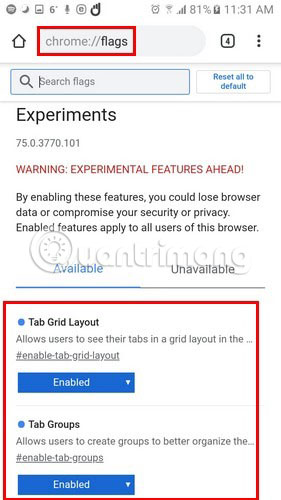How to create tab groups in Chrome on Android with Chrome Flags
Opening multiple tabs on your Android device makes it easy to lose control. Of the many tabs that are open, finding the tab you need is difficult.
The following Chrome Flags will help you group your tabs by subject and be more comfortable when switching from tab to tab. However, there are a few things to consider before you use these Chrome Flags.
Change tab grouping with new test flags in Chrome
- The danger of testing flags in Chrome
- How to access Test Flags in Chrome for Android
- How to activate the necessary flags
- How to access and manage new grouped tabs
- Which design is better?
The danger of testing flags in Chrome
Chrome Flags are experimental features that Google wants to add to the stable version but there are still some bugs that need to be fixed. The fact that these flags are still being tested does not mean they will definitely be added to the stable version.

Is your browser experience at risk of changing in a worse way? Yes of course! Remember that these features are not stable and may cause problems for users. Through the use of these experimental features, you may endanger your privacy and security. You also risk losing browser data.
Don't panic! This does not mean that if you enable test flags, allowing you to group tabs in Chrome on Android, it will definitely cause irreparable damage.
But anything can happen. That's why making changes is necessary, but you have to be sure what you're doing. If you change a flag and are not sure what it will do, you can cause some serious problems.
How to access Test Flags in Chrome for Android
To access the Flags page to test Chrome, enter chrome://flags in the address bar of the browser. At the top, you will see a warning telling you that if you make specific changes, you may lose your browser data or may endanger your privacy and security.
How to activate the necessary flags
You now know how to access the test page in Google Chrome. Next, you must know which flags to look for and turn on. In the search bar at the top, look for the following flags: #enable-tab-grid-layout and #enable-tab-groups .

When you activate them, Chrome will ask you to restart the browser. If you do so and notice that nothing has changed, go ahead and restart Chrome again. This is what the article author has to do during the test.
How to access and manage new grouped tabs
If you don't have any open tabs, continue by opening any one. Click the three dots icon at the top right and select New tab . After you've opened a few tabs, click on the number that shows the number of tabs you've opened. Now, you will see the new design.

One of the tabs you create will have the blue "Create group" option . By selecting this option, the icon of the website you have opened will be at the bottom.
You can open a new tab by clicking the plus sign to the right, three dots at the top right or by clicking the plus icon at the bottom right. To remove a set of grouped tabs, you can click on the X on each tab or slide them aside.

The up arrow does not do anything special, but by clicking on it, you will see the first part of the web page you have visited with that tab. To access grouped tabs, click the number to the right of the Chrome address bar.
If you don't see the blue 'Create group' option , just create another tab. After visiting the website you open that tab, select the number, show you the number of tabs you have opened and the 'Create group' option will reappear.
Which design is better?
When you compare two designs, you can quickly come to the conclusion that the experimental feature looks better. With the old model, you open different tabs in sequence. If you open too many tabs, you won't know where a particular tab is located and have to browse through all the tabs until you find what you need.

With the new design, all tabs are in simple view and to find a specific tab, you just have to swipe down. With the new design, you can group tabs by subject if you want. For example, in a group, you can open websites that contain information on Android and another group that contains websites with iOS-related content.

Another advantage that the experimental design has is the ease of switching from one page to another. Website icons are found below and you do not have to close the site you are viewing to go to another website.
New design that you can enjoy by activating flags is worth testing. After a few days of use, many users reported no problems with these flags.
Are you ready to test a new flag in Chrome? Share ideas with everyone in the comment section below!
You should read it
- How to create permanent tab groups in Google Chrome
- 8 Best Chrome Flags You Should Use
- How does Google Chrome run faster?
- 9 Chrome Flags you should activate to have a better browsing experience
- Tips to help use Chrome on Android effectively may not know you
- How to save web pages on Chrome in group form
- Managing open tabs on Chrome will be a lot easier and more intuitive in the next update
- How to hide The article for you when opening a new Chrome tab on Android
May be interested
- Tips to help use Chrome on Android effectively may not know you
 chrome is the most popular browser today not only on computers, but also on smartphones. therefore, if more tips on using chrome will help you can exploit many unique features of chrome on android.
chrome is the most popular browser today not only on computers, but also on smartphones. therefore, if more tips on using chrome will help you can exploit many unique features of chrome on android. - How to hide The article for you when opening a new Chrome tab on Android
 when opening a new tab on your phone's google chrome, in addition to recent bookmarks, chrome browser will provide you with news suggestions in the article section for you (article for you). if you want a neat new chrome tab, you can turn the feature off to hide the article section for you or you can completely delete these suggestions.
when opening a new tab on your phone's google chrome, in addition to recent bookmarks, chrome browser will provide you with news suggestions in the article section for you (article for you). if you want a neat new chrome tab, you can turn the feature off to hide the article section for you or you can completely delete these suggestions. - Instructions for creating chat groups on Skype
 along with free chat software, voice calls, skype is quite a lot of users choose when you can make calls, or text messages anywhere and on any device. in the process of using, if you have a need to exchange with many people with the same content, the group chat on skype will be much more convenient.
along with free chat software, voice calls, skype is quite a lot of users choose when you can make calls, or text messages anywhere and on any device. in the process of using, if you have a need to exchange with many people with the same content, the group chat on skype will be much more convenient. - Instructions for creating Google Group
 google group makes it easier for many people to exchange and email with each other.
google group makes it easier for many people to exchange and email with each other. - Has Google solved the 'gluttonous' RAM problem of Chrome browser?
 after many updates, it seems that google has finally found an answer to limit chrome eating the system ram.
after many updates, it seems that google has finally found an answer to limit chrome eating the system ram. - Top 7 most useful Chrome extensions you should try
 let's tipsmake.com find out the top 7 most useful chrome extensions you should try in this article!
let's tipsmake.com find out the top 7 most useful chrome extensions you should try in this article! - Google is preparing to 'tighten' Chrome OS and Android more closely together
 through chrome story, it was recently discovered that google is planning to coordinate android and chrome os more closely together.
through chrome story, it was recently discovered that google is planning to coordinate android and chrome os more closely together. - How to create a Chrome theme quickly
 chrome makes it easy to create your own browser theme with just a few mouse clicks. choose your preferred color for chrome browser toolbar and set wallpaper right from the new tab page.
chrome makes it easy to create your own browser theme with just a few mouse clicks. choose your preferred color for chrome browser toolbar and set wallpaper right from the new tab page. - How to turn off all notifications from Groups on Facebook
 turning off notifications from groups on facebook will help users reduce the inconvenience of appearing notifications from groups, such as invitations to join, or post announcements on groups like .
turning off notifications from groups on facebook will help users reduce the inconvenience of appearing notifications from groups, such as invitations to join, or post announcements on groups like . - HOT: Google will merge Chrome OS and Android into a single platform
 google's effort to combine chrome os and android could power low-cost laptops like chromebooks, turning them into more versatile devices for both work and play.
google's effort to combine chrome os and android could power low-cost laptops like chromebooks, turning them into more versatile devices for both work and play.










 How to install Chrome extension on Android
How to install Chrome extension on Android 4 useful tricks for Chrome browser on Android
4 useful tricks for Chrome browser on Android Google Chrome's new offline browsing features make Pocket redundant
Google Chrome's new offline browsing features make Pocket redundant Face point 15 the safest web browser for Android
Face point 15 the safest web browser for Android The unique feature of Firefox Rocket browser on Android
The unique feature of Firefox Rocket browser on Android Which browser is the fastest on Android: Chrome, Firefox, Samsung Browser or Edge?
Which browser is the fastest on Android: Chrome, Firefox, Samsung Browser or Edge?